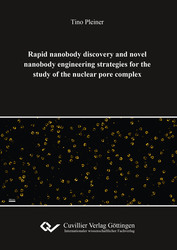| Areas | |
|---|---|
| Serie de libros (96) |
1378
|
| Nachhaltigkeit |
3
|
| Gesundheitswesen |
1
|
| Letra |
2365
|
| Ciencias Naturales |
5406
|
| Matemática | 229 |
| Informática | 319 |
| Física | 980 |
| Química | 1363 |
| Geociencias | 131 |
| Medicina humana | 243 |
| Estomatología | 10 |
| Veterinaria | 108 |
| Farmacia | 147 |
| Biología | 835 |
| Bioquímica, biología molecular, tecnología genética | 121 |
| Biofísica | 25 |
| Nutrición | 45 |
| Agricultura | 1004 |
| Silvicultura | 201 |
| Horticultura | 20 |
| Ecología y conservación de la tierra | 148 |
| Ciencias Ingeniería |
1793
|
| General |
98
|
|
Leitlinien Unfallchirurgie
5. Auflage bestellen |
|
Erweiterte Suche
Rapid nanobody discovery and novel nanobody engineering strategies for the study of the nuclear pore complex (Tienda española)
Tino Pleiner (Autor)Previo
Indice, PDF (84 KB)
Lectura de prueba, PDF (440 KB)
Nanobodies are recombinant single-domain antibodies of camelid origin. We set out to generate nanobodies as tools to study nuclear pore complexes (NPCs) that constitute the major passageways for nucleocytoplasmic exchange. Therefore, we developed an optimized phage display-based workflow for the generation of nanobodies from an immunized animal. The identified nanobodies were functionally expressed in the E. coli cytoplasm in a disulfide bond-free form, thus overcoming the engineering limitations imposed by conventional periplasmic secretion. Using protease-cleavable affinity tags, we developed a generic strategy for native protein complex isolation from eukaryotic sources, e.g. for structural analyses by electron microscopy. We further established a reliable fluorescent labeling strategy of nanobodies that is based on engineered surface cysteines and maleimide chemistry. In contrast to NHS labeling of lysines, maleimide labeling is site-specific, does not interfere with antigen recognition and yields superior imaging reagents, especially for super-resolution microscopy. Using our optimized workflow, we obtained a large toolbox of nanobodies against constituents of Xenopus NPCs that can now be used to study various unresolved aspects of NPC structure, assembly and function.
| ISBN-13 (Impresion) | 9783736995154 |
| ISBN-13 (E-Book) | 9783736985155 |
| Formato | A5 |
| Idioma | Inglés |
| Numero de paginas | 154 |
| Laminacion de la cubierta | Brillante |
| Edicion | 1. Aufl. |
| Lugar de publicacion | Göttingen |
| Lugar de la disertacion | Göttingen |
| Fecha de publicacion | 03.04.2017 |
| Clasificacion simple | Tesis doctoral |
| Area |
Bioquímica, biología molecular, tecnología genética
|
| Palabras claves | Phage Display, Antibody engineering, Nanobody, Single domain antibody, Nuclear pore complex, NPC, Nucleocytoplasmic transport, Xenopus laevis |








